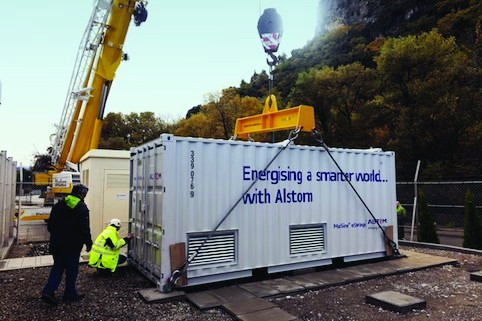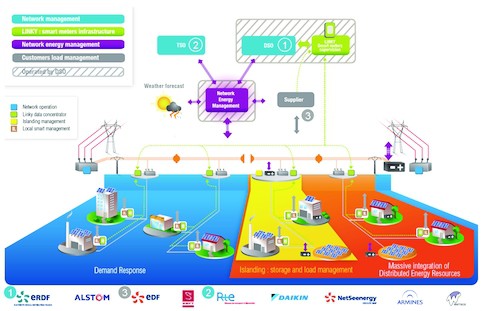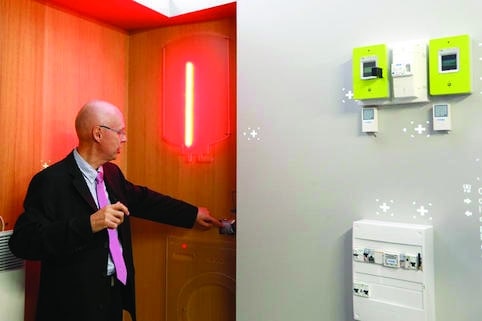But oddly, there seems to be little consensus on what a smart city actually is, what it does or why it should exist. Ask the questions ‘Smart how? And for whose benefit?’ and you’re quite likely to get either a blank look or a rush of jargon generally involving the terms ‘big data’, ‘human/IT capital’, ‘top down’, ‘bottom up’ or ‘multimodal’. Concrete examples of how a smart city might actually work and how it might solve problems are few and far between.

It was refreshing, therefore, to be able to visit a pilot scheme applying smart city principles to a real technological issue that cities are increasingly going to face in coming years: rather than other smart city projects, which distribute sensors over a region to gather data on traffic, air quality, light levels and so on, this is a smart grid project, which is strictly focused on how a reliable electricity distribution infrastructure can be maintained when the power is being generated by a variety of sources, including a significant proportion of renewables that are, to a greater or lesser extent, intermittent.
Alstom is the lead partner in a consortium of companies behind the Nice Smartgrid project, which, despite its name, actually covers only a fairly small suburb of the French Riviera city: a region called Corros, which contains a variety of housing types and several industrial areas with businesses with a range of energy demands. Other participants include battery specialist Saft, EDF, electricity distributor ERDF and local development agencies, including the French environmental and energy agency, ADEME. The project is set to last for four years and is costing €30m (£24.6m), split between the French government’s Future Investments programme and the European Union’s FP7 science and technology R&D programme.

Nice, and Carros in particular, are suitable for this experiment for several reasons. First, the entire Riviera is an ‘electricity island’, served by a single 400kV high-voltage line operated by RTE. This means it’s fairly easy to isolate areas to see how they can operate running only on their own ability to generate.
Second, Carros does have a considerable ability to generate: many buildings, both residential and commercial, have photovoltaic (PV) panels on their roofs that are linked to the local grid and can therefore supply power both to their own building and to distribution substations. The project involves around 1,500 participants and has seen Alstom smart meters, substations and electricity storage systems using Saft’s shipping-container-based megawatt lithium-ion battery technology teamed with Alstom’s MaxSine ‘estorage’ converters, which charge or drain the batteries based on demand across the grid.
The main goal of the project is to trial demand management to ensure that those customers (the project calls them ‘prosumers’) who most need power at any given time have access to what they need, while generation, storage and inputs from the main grid are managed and kept in balance over the course of the day. The area is split into three overlapping zones: Zone 1 is the whole area, fed by four medium-voltage lines from the single Cote d’Azur cable, with a total of 5MW load-shedding and battery storage capacity; Zone 2 is a ‘smart solar district’ with 200 customers equipped with photovoltaic panels, with a generating capacity of some 2–3MWp; and Zone 3 is an ‘islanded mode test zone’ that can be completely isolated from the rest of Carros to meet its demand entirely by PV.
The domestic prosumers have been equipped with smart meters provided by ERDF. Known as ‘Linkys’, these use power-line conversion to transmit and receive data — in other words, they modify the AC electrical current to carry a signal (in the same way as broadband data are sent around a house from internet hub to television set-top boxes, for example); these are becoming a standard product in France. Some 130 customers who have signed up for demand reduction have a choice: they can either switch off energy-hungry appliances at notified times when demand is high (for example, when it’s particularly cold; in France, most domestic heating is electric) or they can turn over control of their heating to the Linky box for 30–90 minutes, during which the system will minimise the energy used by the heaters to best maintain a comfortable temperature.

Patrick Plas, Alstom’s senior vice-president for power electronics and automation, summed up the slippery definition of smart grid as ‘a two-way flow of energy and real-time information between suppliers and customers’. This is very important for Alstom, he added, because of several factors, the most important of which is the speed of growth of the market — some 75 per cent between 2013 and 2020; this is driven by the accelerating urbanisation of the world’s population — cities cover just two per cent of the world’s surface but are home for more than half of the humans alive, consume 75 per cent of all energy produced, and are responsible for 80 per cent of all carbon emissions.
Whatever our feelings about renewable energy, it’s going to be an inescapable part of the energy mix; as overall demand for electricity increases, which it’s predicted to do by 50–70 per cent by 2030 with 80 per cent of this in the OECD (of that 80 per cent, 38 per cent will be in China and 13 per cent in India), there is no alternative but to use diverse sources. Even France, the most pro-nuclear power nation on Earth, would not contemplate the costs of expanding its nuclear fleet that much, while cost, security, supply and carbon emission concerns rule out more hydrocarbon-burning-based generation.
‘Generation and infrastructure for this new demand will each cost around $6tn,’ Plas said, ‘and we estimate that using smart grids will reduce the capital expenditure by 20 per cent. And you need the smartness on board, because it’s so difficult to even predict how much solar power you’re going to get in any one particular place. It’s getting easier to predict wind, but even then it’s never going to be 100 per cent.’ Renewable energy is predicted to meet 30 per cent of worldwide electricity needs by 2030; in Europe, that proportion will be 45 per cent and in Latin America more than 70 per cent.
‘There’s a huge volatility in energy cost; it’s imperative that we find solutions for reliable, affordable power with more renewables,’ Plas said. ‘And we can take advantage of new technologies such as efficient power electronics, in devices such as flexible air conditioning and storage converters, and cloud computing to assist in real-time information transfer.’
Development of these systems has been a long journey that is still not at an end, Plas said. ‘We started on stability and energy management 30 years ago, and renewables integration about five years ago.’ There are somewhat different technological challenges with setting up smart grids in the various global regions, Plas added. ‘In North America, the main issue is grid efficiency; in Europe, it’s the issue of renewables.’
There are also technological issues that are still emerging and cannot yet be modelled even in a large-scale scheme such as Carros. Chief among these is the impact of electric cars, whose batteries are likely to form an important component of energy storage, quite possibly the main one for domestic users (it’s possible that houses could be equipped with their own high-capacity storage, but depending on how car batteries are used, this might not be necessary). This, however, is currently an imponderable because electric vehicles are still not widespread enough, and the infrastructure to allow their batteries’ two -way access to the grid does not yet exist. ‘We can’t draw any conclusions yet; we need much better information about how people are going to use these systems,’ Plas said. ‘It depends on how people use their cars, how long they are plugged in for and in which locations, and the power electronics handling their charging and discharging.’
Storage is hugely important to the Carros grid, because of a fundamental mismatch between generation and consumption phases: the solar panels generate electricity mostly between 08:00 and 16:00, which is the lowest-consumption time of the day (peaks are before 08:00, when most people are having morning showers and making breakfast, and after 17.30, when they get home from work and school). The Linky meters provide forecasts for load and generation for the local control rooms, which act as data aggregators and tell the system’s energy managers how much flexibility they have with respect to storage — generally using the Saft battery systems — and demand reduction, which depends on which consumers have opted in and how they have chosen to respond to demand requests. The control rooms are a mission-critical part of the network, ensuring that all its component parts act in concert and managing transactions between consumers, generators and storage.
Industrial users provide much of the system’s flexibility. One of the first to sign up was coffee producer Malongo, a longstanding EDF customer, which had previously subscribed to an agreement to source 100 per cent of its energy from renewables. The company operates a roastery in Carros and is therefore a bulk user of electricity, but as part of the smart city project it has agreed that, twice a week in the summer, it will switch off one of its three roasting lines during peak periods. This reduces its energy spend by some 60 per cent and, along with the contribution from other large-scale industrial users, cuts power demand by 1.6MW.
The tentacles of the operation reach much wider than the Riviera, though: all the way into low-Earth orbit, in fact. Weather forecasting is a vital part of the picture; although as mentioned it’s very difficult to obtain reliable forecasts down to the detail of where the sun is going to shine, where and how low clouds are going to break and which solar installations will be most productive. Nonetheless, the forecast over the entire region still gives valuable detail for how much power overall the renewables can add to the grid. ‘The more information we can put into the system, the better,’ said Gregoire Poux-Guillaume, president of Alstom Grid. ‘Of course that applies whatever form of renewables we’re looking at; they’re all weather-dependent. The technologies we’re looking at here are directly transferable to any form of renewables, although the detail will differ. In Carros, we have a lot of small energy producers, with many buildings with a few solar panels.
In other places, you have large solar farms, which contribute a much larger lump of power, so to speak. In the UK, renewable energy tends to be concentrated in moderate to very large wind farms, smaller marine energy systems — although those will grow — and some large solar farms; and none of these tend to be close to the centres of consumption. Germany has a quite similar situation, with lots of wind farms in the north but most of the energy-consuming industry in the south. In that case, there’s a large-capacity distribution line connecting the two regions, so the scale and the architecture are very different from what we have here in Carros, but the underlying principles are exactly the same.’
Information security is an important part of the system, as it involves data transfer between private residences, commercial interests and municipal authorities. ‘We are evaluating to what extent we’d need to install dedicated communications lines for security purposes,’ Poux-Guillaume said. ‘In most cases, though, we can probably use existing infrastructure with some added precautions.’
Poux-Guilllaume is candid about the real purpose of smart city systems. ‘It’s accurate to say that the biggest advantage is that it hides the unreliability of renewables from consumers,’ he said. ‘It’s a fact that they don’t work the same way as large power stations, but people and businesses need that reliable supply that large power stations guarantee. As we know that we’re going to have a lot more renewables in the future, this is the best way of integrating those systems.’




April 1886: the Brunkebergs tunnel
First ever example of a ground source heat pump?